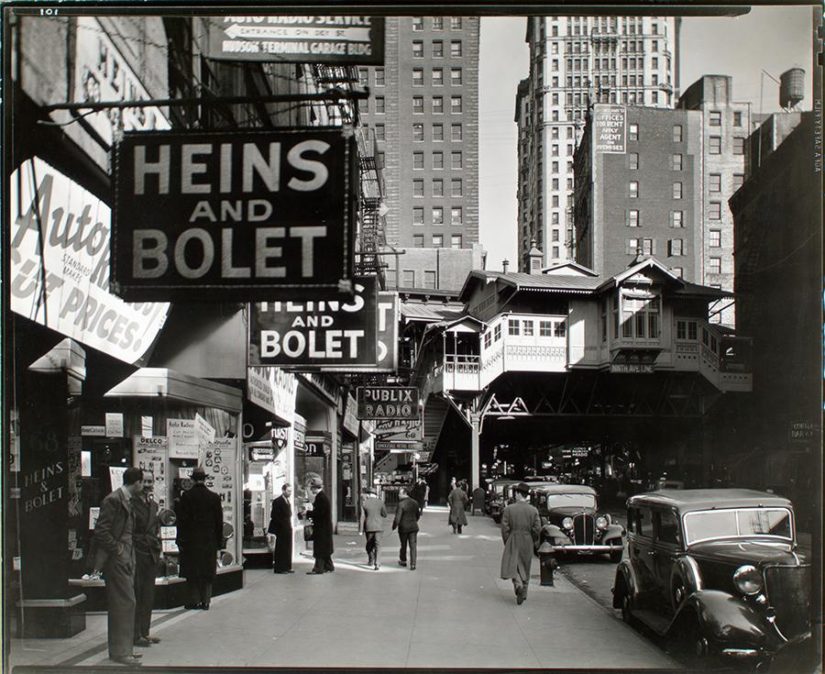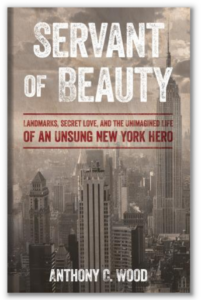
Radio Row
Radio Row was a neighborhood/commercial district that existed in the footprint of what subsequently became the World Trade Center. It was a crowded series of shops selling consumer electronics that rose during the 1920s due to the rise of home electronics and radio technology. It was demolished in the 1960s for the Port Authority’s World Trade Center project. This was, however, after a multi-year legal fight by Radio Row entrepreneur Oscar Nadel and his Downtown West Small Business Survival Committee.
Radio Row was the colloquial nickname for a neighborhood in Lower Manhattan bounded largely by Barclay Street to the north, Church Street to the east, Liberty Street to the south, and the Hudson River to the west. Due to its proximity to the New Jersey ferries and the Financial District, this neighborhood developed into a web of electronic stores catering to standard consumer electronics and radio hobbyists as early as the 1920s.[1] The New York Times’ Martin Arnold described the area in April 1962 as, “one of the city’s oldest, most vital, and most colorful commercial centers.” Arnold continued, “The area abounds with flower and plant shops, hardware stores, book stalls, restaurants and a hundred other enterprises. But it is mainly known as the East Coast Center for hi-fi and ham-radio addicts – its streets are filled with shoppers, many of whom have come from hundreds of miles away.”[2] Radio Row entrepreneur Oscar Nadel claimed that “1,600 commercial businesses doing an annual business volume of $300,000,000 and employing about 30,000 persons,” were crammed into the neighborhood.[3] The neighborhood was largely razed in the 1960s at the behest of the Port Authority to build the World Trade Center complex. The neighborhood, however, did not disappear without a spirited fight.
[1] Syd Steinhardt, “The Death of New York’s Radio Row,” (2002).
[2] Martin Arnold, “Merchants Score Downtown Plan,” The New York Times (New York City), April 20th, 1962, 1962.
[3] Ibid.
Originally, the Port Authority planned to build the World Trade Center in Manhattan along the East River in the area of the South Street Seaport. Another discussed WTC location was Exchange Place before the Port Authority settled on the Radio Row area location on the west side of Manhattan island.[1] That space was selected because the Port Authority had recently acquired the Hudson tubes under the Hudson River, giving the entity air rights over the Hudson Terminal station.[2] This meant tearing down what used to be the world’s largest office building that was already at the site, a massive neoclassical twin towered complex built by James Hollis Wells of architecture firm Clinton and Russell in 1908, but this was only a fraction of the proposed footprint. Almost immediately after the Port Authority declared the West side as its preferred World Trade Center location, Radio Row shop owners started seeing engineers testing the ground. According to Radio Row grocer George Kallimanis, an engineer told him, “Buster, once the legislation is passed, you’re going to be out of here in six months.”[3]
Entrepreneur Oscar Nadel, in response to the ever-expanding World Trade Center plans, created the “Downtown West Small Business Survival Committee.” In the spring of 1962, three hundred Radio Row employees and businessmen met in Academy Hall near Union Square to discuss the looming threat to their businesses.[4] Radio Row resistance leader Oscar Nadel, owner of “Oscar’s Radio Shop,” turned out to be a wily public force, consistently finding himself quoted in local press such as The New York Times as the representative for the Radio Row merchants. In July of 1962, a month before the famed AGBANY picket in front of old Pennsylvania Station, the ever-dramatic Radio Row entrepreneurs staged a mock-funeral where they carried around a black-draped casket containing the “Small Business Man,” with Nadel himself climbing into the casket playacting as the dead.[5]
Oscar Nadel and his Radio Row fighters framed their fight as one for entrepreneurial liberty. Nadel said, “This is not some foreign country where the government can come in and just take a man’s business. This is a world-wide center for electronics for the home and now they are going to destroy it so that the real-estate interests can take over.”[6]
The successful PR by Nadel and his survival committee served, to quote James Glanz and Eric Lipton, “as a catalyst that helped draw some of the city’s most powerful real estate interests into the fight against the trade center.”[7] Around Thanksgiving 1962, the New York State Appellate Court began hearing arguments about the constitutionality of Port Authority’s project.[8] Nadel and famed human rights lawyer Morris Ernst were able to take the fight against the Port Authority all the way to the Supreme Court.[9]
The vigorous public relations effort, the legal battles, and the activist pageantry by Nadel, however, were ultimately unsuccessful. The Supreme Court of the United States declined to block the World Trade Center project, allowing the Port Authority to move forward with destroying Radio Row.[10] Nadel and his committee continued to fight, with delicatessen owner Barry Ray even writing the governments of 11 different European nations to get help for the cause.[11] It was simply too little too late. As early as 1965, land was condemned to make way for the World Trade Center.[12] On March 21st, 1966, Ajax Wrecking and Lumber Company started the process of demolition, destroying 6 buildings on Dey Street.[13]
1920s to 1960s: Radio Row’s heyday as a commercial neighborhood
December 22, 1961: The Port Authority announces that World Trade Center project will be on Radio Row site
April 20, 1962: Nadel tells The New York Times that the merchants “intend to fight.”
July 14, 1962: Nadel and his Survival Committee parade a coffin to protest the World Trade Center
November 13, 1963: Supreme Court sides with Port Authority, allows World Trade Center to be built at Radio Row site.
June 26, 1964: Survival Committee writes to governments in Europe for support
September 14, 1965: First condemnations for World Trade Center site
Demolished
[1] John A Ward, NYT, March 16 1961, Trade Center Queried
[2] “Hudson Tubes Sale Is Approved by I.C.C.,” New York Times (New York), August 29, 1962, 1962.
[3] James Glanz and Eric Lipton, City in the Sky: The Rise and Fall of the World Trade Center (New York: Times Books, 2003), 63.
[4] Lipton, 70
[5] Edith Evans Asbury, “Downtown Merchants Parade Protest World Trade Center,” The New York Times (New York City), July 14th, 1962, 1962.
[6] Arnold.
[7] Lipton, 64.
[8] Lipton, 82.
[9] Lipton, 70.
[10] Martin Arnold, “High Court Plea Is Lost by Foes of Trade Center,” The New York Times (New York City)1963.
[11] David Anderson, “Trade Center Foe Broadens Attack,” The New York Times (New York City)1964.
[12] William Robbins, “Land Acquisition for Center Due,” The New York Times (New York City)1965.
[13] Laurel Corona, The World Trade Center (San Diego: Lucent Books, 2002), 38.




